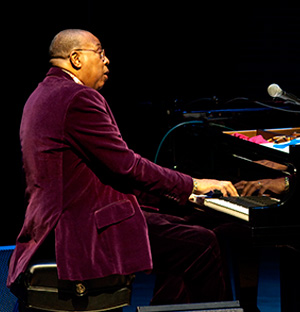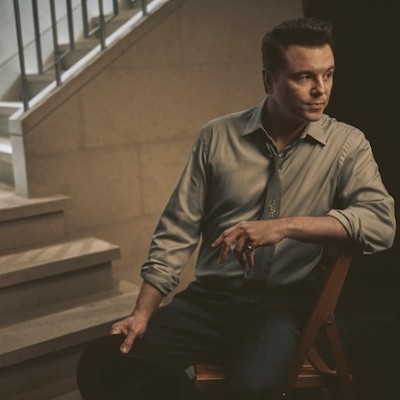Dec 9, 2025 12:28 PM
In Memoriam: Gordon Goodwin, 1954–2025
Gordon Goodwin, an award-winning saxophonist, pianist, bandleader, composer and arranger, died Dec. 8 in Los Angeles.…

Chucho Valdés at Carnegie Hall (Photo: Fran Kaufman)
(Photo: )When Dizzy Gillespie and Chano Pozo introduced Afro-Cuban jazz to the masses, they gave us world music—quite literally. Much like the country itself, Cuba’s music is a hybrid of classical, jazz and African rhythms. Artists like the late Mongo Santamaría, Machito and Tito Puente have kept all us fascinated with their musical exploration of the relationship between cultures. Chucho Valdés also has made a career out of exploring the intersection of jazz and global rhythms. These days, the legendary Cuban pianist looks to his past in order to forge ahead.
That was certainly the case during his Dec. 1 performance with his quintet in Zankel Hall, part of Carnegie Hall’s monthlong “Voices from Latin America” series. As he walked onto the stage, a humble giant that appeared to hover over crowd, Valdés folded his hands into prayer and bowed with gratitude before he took his seat at the piano.
“Bésame Mucho,” written by Mexican classical pianist Consuelo Velázquez, was certainly an interesting opener for the 90-minute set. Nevertheless, Valdés’ arrangement illustrated why he is considered as an icon of Latin jazz. Transitioning from the steady-handed trills of McCoy Tyner to a Bach fugue, Valdés painted a detailed picture of his musical upbringing.
The intimacy on “Pilar,” a song that Valdés wrote for his mother, came from both the contemplative music itself and the instrumentation of bass, piano and drums only with the temporary exclusion of Dreiser Durruthy Bombalé on the batá drum and Yaroldy Abreu Robles on congas. With a gentle nod to Miles Davis’ “Blue In Green,” Valdés’s melodic chords were framed around bassist Angel Gaston Joya Perellada, who opened the number with a bow in hand while drummer Rodney Yllarza Barreto provided the right amount of snare, keeping with the overall melancholy mood of the number.
DownBeat caught up with Valdés in The Maestro dressing room at Carnegie Hall before his Dec. 4 concert with three other piano greats—Danilo Pérez, Egberto Gismonti and Gonzalo Rubalcaba. (His translator was Tatiana García Altagracia.)
At what point in your life did you know that you would become a professional musician?
I started playing piano when I was 3 years old. My parents said that I was just born to play, so I just popped out and started [playing]. I started listening to my dad, Bebo Valdés, and that’s when it all just [happened]. So since childhood, I felt that I was going to be a musician. There was just something in me already—there was no other question.
During the Dec. 1 performance with your quintet, one could hear the varied influences in your playing—classical, modern jazz, African. Other than your father, who inspired you early on?
Growing up in my house, my father played a lot of genres [because] he was a very devoted musician who played at The Tropicana [Club]. In order to play at Tropicana, you had to know a lot of genres because every night has a different genre, a different style of music. Every six months, Tropicana had a theme. For instance, each time when they played Brazilian, for those six months it was all about Brazilian music. That would change, and then another six months about the blues and jazz. Milt Jackson, Buddy Rich, Billy Taylor, Roy Haynes, Sarah Vaughn, Nat King Cole—these are the people that I saw at Tropicana. So the musicians needed to know all the genres in order to accompany them. So that was a big influence. After the shows, there were these jam sessions with Cuban and American musicians which were also a part of that structure and influence. So there was jazz, samba, classical, even Spanish and Flamenco style kind of music. My father always wanted me to understand these genres and that’s how I got many, many influences at a young age. For my classical education, I studied at the Municipal Music Conservatory of Havana. The batá musician that you saw was chanting in this ancient language of the Yoruba called lucumí. The Yoruba influence of the music was because of my neighborhood and childhood.
In 1964, I had a small group and we recorded two albums. The idea was already forming in my mind of what would later become Irakere. Paquito D’Rivera was already a member. He had to be around 15 years old at the time. He was phenomenal and a prodigious child. When Paquito was 8 years old, he could already play Mozart. When we were making the group with bass player Carlos Del Puerto and percussionist Oscar Valdés, I formed a trio called Jazz Batá and composed a song called “Irakere” with the trio. It wasn’t close to forming the group—just a song back then. We played in the Cuban Modern Music Orchestra and [eventually] Carlos, Oscar and I separated from the orchestra to form Irakere. Paquito came on, and then we added conga player Tato [Alfonso], drummer Bernardo Garcia and guitarist Carlos Emilio Morales, and we formed Irakere in 1973. It was instantaneous. How I grew up and all of the influence, it was just a tribe with many possibilities. It was a time and opportunity to blend them all in. With elements of classical music that I studied at the conservatory and Santería, they combined and became this genre and it’s had much success.
Several artists have since left Irakere—yourself, D’Rivera, Arturo Sandoval—and have gone on to have successful solo careers. At the time, did you all feel that you had ample room to experiment musically?
I believe that the group achieved what it [set out] to do—creatively, especially. But I needed a change within myself, a musical change. I needed to bring out Chucho the pianist. I have developed myself as a pianist, a solo player, and I have discovered many things that I could not discover in Irakere because there were four major kinds of musicians. As a solo musician, I have had a lot of fulfillness in [tapping into] new genres and possibilities for myself.
Are there any plans for Irakere reunite in the future?
I would like to, but the original members of the group, it’s difficult because each one has their own career. As for me, it would be fantastic. —Shannon J. Effinger
Goodwin was one of the most acclaimed, successful and influential jazz musicians of his generation. Dec 9, 2025 12:28 PM Gordon Goodwin, an award-winning saxophonist, pianist, bandleader, composer and arranger, died Dec. 8 in Los Angeles.… Flea has returned to his first instrument — the trumpet — and assembled a dream band of jazz musicians to record a new album. Dec 2, 2025 2:01 AM After a nearly five-decade career as one of his generation’s defining rock bassists, Flea has returned to his first… “It’s a pleasure and an honor to interpret the music of Oscar Peterson in his native city,” said Jim Doxas in regard to celebrating the Canadian legend. “He traveled the world, but never forgot Montreal.” Nov 18, 2025 12:16 PM In the pantheon of jazz luminaries, few shine as brightly, or swing as hard, as Oscar Peterson. A century ago, a… Dec 11, 2025 11:00 AM DownBeat presents a complete list of the 4-, 4½- and 5-star albums from 2025 in one convenient package. It’s a great… Seth MacFarlane takes a turn from his television and film career to sing arrangements made for Frank Sinatra, but never recorded. Nov 18, 2025 12:04 PM “I’m not gonna lie to you — I don’t know why I thought this was about The Naked Gun, but I’m happy it’s…
In other news... DownBeat's Most Read Stories

In Memoriam: Gordon Goodwin, 1954–2025

Flea Makes a Plea with Song from Jazz Dream Team Project

Oscar Peterson at 100: A Worldwide Celebration

Best Albums of 2025

Seth MacFarlane Takes on Lost Sinatra Arrangements